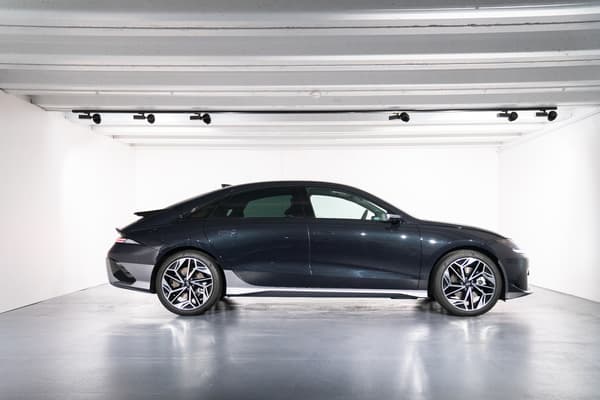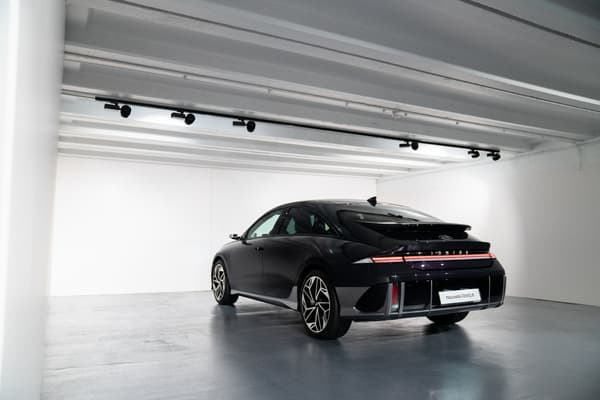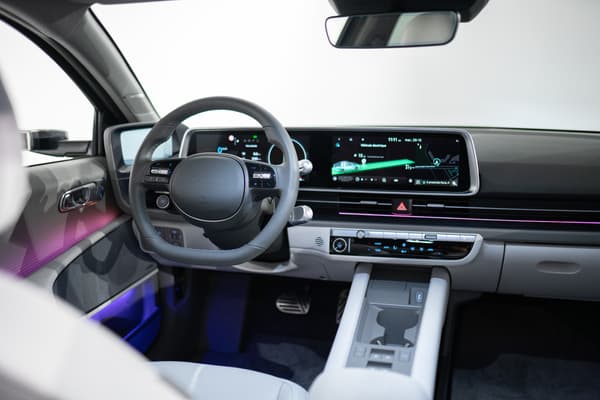It was a small lesson in efficiency that Hyundai is giving with its new Ioniq 6. The great sedan, in fact, is based on advanced aerodynamics to show very low consumption levels for a model of this size. Indeed, we are facing a beautiful baby, with a length of 4.85 meters, 16 centimeters longer than a Tesla Model 3.
Different combinations: battery, motors, tires
Faced with the Ioniq 5 SUV, which shares the same technical base, Hyundai has worked especially on its penetration into the air, enough to gain about 100 kilometers of autonomy compared to its cousin in the range.
The best combination to limit consumption, the “small” battery (53 kWh), to limit the weight on board, a single motor, placed in the rear and developing a reasonable power of 153 horsepower, all with 18-inch wheels , to achieve a displayed consumption of 13.9 kWh at 100 kilometers. Impressive for this type of vehicle, even if this remains to be verified during tests in real conditions. This is also the only possible association for the battery with a limited capacity, allowing it to show 429 kilometers of autonomy.

By moving to the larger battery (77 kWh) and a more powerful engine (228 horsepower), consumption increases logically but slightly, up to 14.3 kWh at 100 km, to achieve maximum autonomy in this model, 614 kilometres.
An increase in power, with a second engine placed in the front for an accumulated power of 325 horsepower, or larger wheels, in 20 inches, will increase consumption and lower autonomy, at least up to 519 kilometers.
Fast charging as well
If this Ioniq 6 is an electric marathon runner, it is still a good sprinter. In fact, 0 to 100 km/h is dispatched in just over 5 seconds for the most efficient version.
But it is above all on the recharging power side that the Ioniq 6 impresses: with its 800-volt architecture as standard, a “full” to recover 350 kilometers of autonomy will only take 15 minutes, on a 350 KW ultra-fast charger. and reaching a load power of 239 kW. A time close to what is usually taken in a motorway service area to refuel, park and “take to the pits”, as they say.
Bold design options
Such aerodynamics require various tricks, but in general Hyundai explains that it was inspired by today’s “Streamliners”: these American models of the 1920s that sought to optimize this aspect, with body lines that allowed maximum air flow around the vehicle. in the most harmonious way possible.

The result is an unconventional profile, but one that offers a certain charm, especially at the rear with a spoiler reminiscent of the Porsche 911. At the front, the flaps can be opened or closed to optimize air intake. Lastly, the usual body-flush handles and camera mirrors add their stone to this aerodynamic structure.
Hyundai tickles the cousin
Inside, the environment is as refined as in the Ioniq 5, but with a style that stands out especially at the level of the center console. Sliding over the SUV, with the possibility of freeing up a lot of space, it clearly separates the driver from the passenger here.

This console is surrounded by fabric, but mostly made of a gray plastic, not necessarily the most beautiful effect (but more noticeable than a pretty but very messy “black piano”). One of the rare signs that we are still with a so-called “generalist” brand as the whole exudes a certain harmony, both in terms of technology – with a particularly well-integrated combination of screens – and ergonomics. Especially with the climate controls separate from the screen.
After the Ioniq 6, an Ioniq 7 to come
Side price, pre-orders will open on November 3 for a launch edition in five European markets: 2,500 copies in total, including 250 for France. Although the Korean brand has made great progress in our market in recent years (3.1% market share since the beginning of the year), the performance is even better in Germany (4%), in the United Kingdom (5, 1%) and in Spain (7.4%).
In particular, with its switch to electric, Hyundai has increased its average selling price. Much more to do with its positioning as a low-cost brand in the early 2000s. Without going that far, the budget of a Hyundai buyer in France was still just under €23,000 in 2015, to be close to the 35,000 euros at the end. of 2021.
And it will take a little longer to afford an Ioniq 6, the new flagship of its range waiting for the great Ioniq 7 SUV. In case they are not yet known, Hyundai mentions prices close to its Ioniq 5, whose sale price currently starts from 46,000 euros in France.
Source: BFM TV

